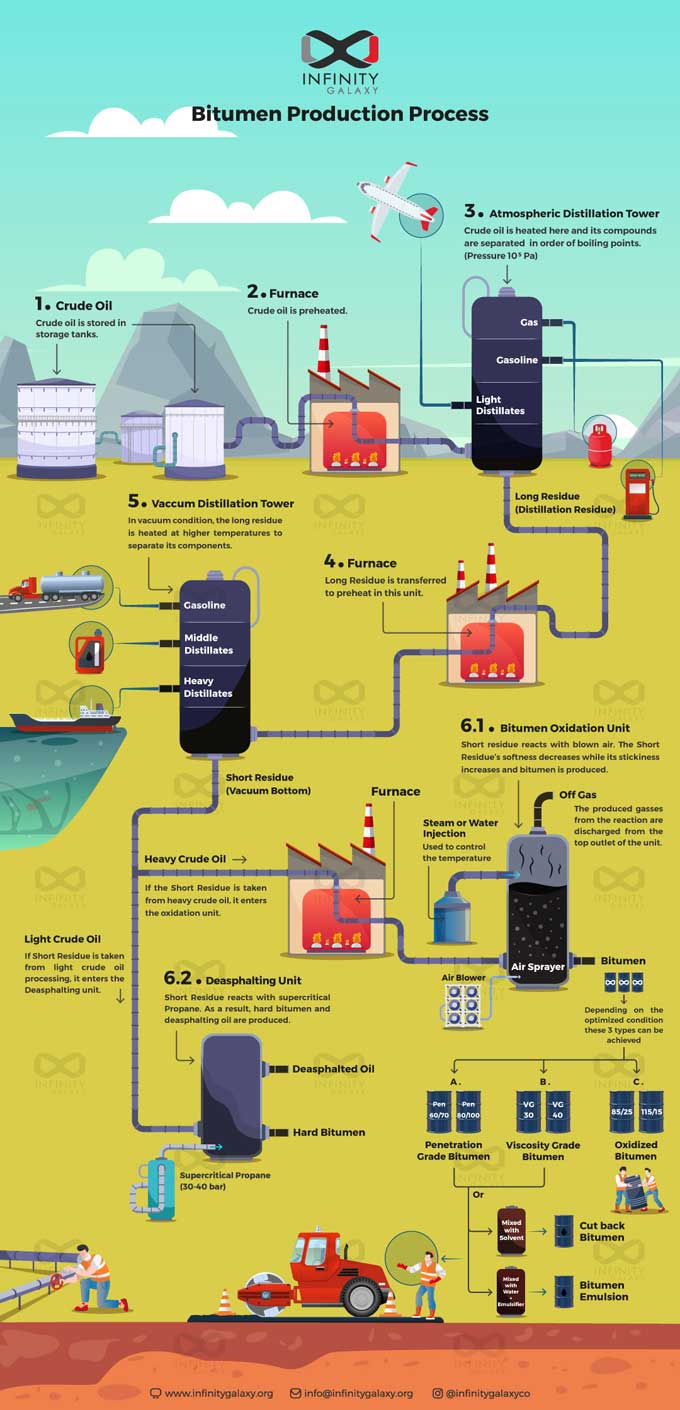NEWS | SOFTWARE | SHEET
Bitumen Production Processes
Bitumen is one of the products of crude oil processing. The properties of bitumen are influenced by the source of oil and the process of oil processing technology. Therefore, there are several methods for producing bitumen including Distillation (Straight Run), Air Blowing, Blending, and Solvent Deasphalting.
Stay with us to learn about bitumen production methods.
Distillation (Straight Run)
The most common method of bitumen production is distillation. At the first stage, atmospheric distillation is used to separate light compounds with a low boiling point from oil.In atmospheric distillation, oil is heated to a temperature of 300 to 350 centigrade. Light parts of oil such as fuel oil, kerosene, and gasoline are separated from the upper parts of the atmospheric distillation tower.
The residual of the non-boiling component in the atmospheric distillation tower is known as the Atmospheric Residue. To remove the last trace of the light fractions and also to prevent the thermal cracking of the molecules, the atmospheric residue is introduced into a vacuum distillation tower.
In the vacuum distillation tower, reducing the pressure reduces the boiling point and separates any light component.The residue of this tower is called the vacuum bottom. Vacuum bottom is very similar to bitumen, which is called straight run bitumen.
Air Blowing
Air Blowing is the main way to produce bitumen. In this process, the air is blown into bitumen feedstock with a flow rate of 85-140 cubic meters per minute in high temperatures. By blowing air, the physical properties of bitumen change for different applications.
The main purpose of blowing air is to stiffen the bitumen. Therefore, the viscosity and softening point of bitumen increase and bitumen penetration decreases. Blowing air is done in two ways, Air Rectification and Fully Air.
A. Air Rectification
In the air rectification method, the air is blown to a mild degree. In this method, minor changes in the physical properties of bitumen such as reducing penetration and increasing bitumen viscosity take place. This method is performed in two ways: Batch Blowing and Continuous Blowing. In the batch blowing method, the blowing tower is filled with a certain volume of feedstock. Blowing air occurs under certain conditions of temperature and time. When the product reaches the desired specifications, the tower is emptied.
In the continuous process, the vacuum bottom enters the reactor with a constant and controllable flow rate. After air blowing under stable operating conditions, it is continuously discharged from the air blowing tower. In this method, more bitumen is produced per unit of time than the batch method.
B. Fully Air Blowing
In the fully air Blowing method, more air passes through the feedstock than air rectification. By increasing the amount of air blowing, oxidation increases and changes the extent of the reaction, so different final products are produced including bitumen penetration grade, viscosity grade and oxidized bitumen.
In this process, by controlling the reaction variables, oxidized bitumens with specific physical and chemical properties can be prepared. For example, chemical reactions lead to an increase in the apparent molecular weight and polarity of bitumen. These bitumens can be widely used in roofing applications.
Infinity Galaxy, as an international supplier of bitumen, has prepared an infographic on the topic of bitumen production by blowing air. Reading this infographic will give you a better understanding of bitumen production.
Blending
Typically, bitumen is produced directly in a refining process or by blending bitumens with different physical properties. In this method, specific ratios of bitumen with higher viscosity are mixed with bitumen of lower viscosity to produce bitumen with specific characteristics. For example, it is possible to produce 80/100 bitumen from the combination of bitumen penetration 200/300 and 40/50.
Solvent Deasphalting
One of the methods of bitumen production is solvent deasphalting. In the solvent deasphalting method, solvents such as propane and butane is used to separate bitumen from crude oil. In this method, the vacuum bottom is mixed with propane (butane) and then de-asphaltene oil is extracted from it. The residual products produced by the solvent deasphalting unit are asphaltenes and petroleum resins depending on the process used. It should be noted that the type of crude oil processed and the operational technique used in the de- asphalt unit plays an important role in determining the properties of the produced bitumen.


